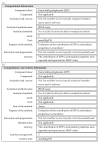Extractable and Non-Extractable Antioxidants Composition in the eBASIS Database: A Key Tool for Dietary Assessment in Human Health and Disease Research
- PMID: 33171921
- PMCID: PMC7694646
- DOI: 10.3390/nu12113405
Extractable and Non-Extractable Antioxidants Composition in the eBASIS Database: A Key Tool for Dietary Assessment in Human Health and Disease Research
Abstract
The antioxidant properties of foods are crucial in nutrition, food chemistry, and medicine studies but are often underestimated, with significant amounts of bioactive compounds containing physiological and biochemical properties remaining in the residue from extraction as non-extractable antioxidants. Over the last decade, extractable and non-extractable compounds have become key in the evaluation/determination of the antioxidant properties of food matrices because of their relevance in human health. This has led to the need to include extractable and non-extractable antioxidants in comprehensive and harmonized food composition databases for a wide range of applications within research, food, pharmaceutical, nutraceutical, and cosmeceutical areas. Additionally, the databases are invaluable as part of the health claims application process. eBASIS, (Bioactive Substances in Food Information System) a comprehensive database containing quality-evaluated scientific data, covering the composition of bioactive compounds present in foods, has flexible structures, allowing it to be extended to include newly emerging data on extractable and non-extractable compounds. Search criteria were developed and defined for compiling suitable peer-reviewed literature. Data quality assessment methods were established for the addition of composition data and antioxidant activity, with a focus on various parameters including: the extraction procedure, the antioxidant measurements, the expression of results. A total of 437 quality-evaluated datapoints on the composition of extractable and/or non-extractable compounds were entered into the database. This database update represents one of the first examples of building a database dedicated to antioxidant properties. This expansion of eBASIS provides a novel and unique tool for nutritionists, dietitians, researchers to use for a wide range of applications, such as dietary assessment, exposure studies and epidemiological studies, and may contribute to an increase in high-bioactive food consumption by consumers.
Keywords: antioxidant properties; bioactive compounds; dietary assessment; dietary intake; eBASIS; extractable compounds; human health; non-extractable compounds; nutrition knowledge.
Conflict of interest statement
The authors declare no conflict of interest.
Figures



Similar articles
-
eBASIS (Bioactive Substances in Food Information Systems) and Bioactive Intakes: Major Updates of the Bioactive Compound Composition and Beneficial Bioeffects Database and the Development of a Probabilistic Model to Assess Intakes in Europe.Nutrients. 2017 Mar 23;9(4):320. doi: 10.3390/nu9040320. Nutrients. 2017. PMID: 28333085 Free PMC article.
-
EuroFIR eBASIS: application for health claims submissions and evaluations.Eur J Clin Nutr. 2010 Nov;64 Suppl 3:S101-7. doi: 10.1038/ejcn.2010.219. Eur J Clin Nutr. 2010. PMID: 21045837
-
Antioxidant Properties of Four Commonly Consumed Popular Italian Dishes.Molecules. 2019 Apr 19;24(8):1543. doi: 10.3390/molecules24081543. Molecules. 2019. PMID: 31010111 Free PMC article.
-
Health benefits of herbs and spices: the past, the present, the future.Med J Aust. 2006 Aug 21;185(S4):S1-S24. doi: 10.5694/j.1326-5377.2006.tb00548.x. Med J Aust. 2006. PMID: 17022438 Review.
-
Antioxidants in food: content, measurement, significance, action, cautions, caveats, and research needs.Adv Food Nutr Res. 2014;71:1-53. doi: 10.1016/B978-0-12-800270-4.00001-8. Adv Food Nutr Res. 2014. PMID: 24484938 Review.
Cited by
-
Food Composition Data and Tools Online and Their Use in Research and Policy: EuroFIR AISBL Contribution in 2022.Nutrients. 2022 Nov 12;14(22):4788. doi: 10.3390/nu14224788. Nutrients. 2022. PMID: 36432474 Free PMC article.
-
Opportunities and challenges in using NIH's Dietary Supplement Label Database for research on non-nutrient ingredients: Use case for ingredients in honeybee products.PharmaNutrition. 2024 Mar;27:100377. doi: 10.1016/j.phanu.2024.100377. Epub 2024 Jan 20. PharmaNutrition. 2024. PMID: 39007096 Free PMC article.
-
Dietary Antioxidants and Metabolic Diseases.Int J Mol Sci. 2021 Nov 22;22(22):12558. doi: 10.3390/ijms222212558. Int J Mol Sci. 2021. PMID: 34830440 Free PMC article.
-
Deciphering antioxidant interactions via data mining and RDKit.Sci Rep. 2025 Jan 3;15(1):670. doi: 10.1038/s41598-024-77948-9. Sci Rep. 2025. PMID: 39753585 Free PMC article.
-
Food Composition and Dedicated Databases: Key Tools for Human Health and Public Nutrition.Nutrients. 2021 Nov 10;13(11):4003. doi: 10.3390/nu13114003. Nutrients. 2021. PMID: 34836257 Free PMC article.
References
MeSH terms
Substances
LinkOut - more resources
Full Text Sources
Medical

